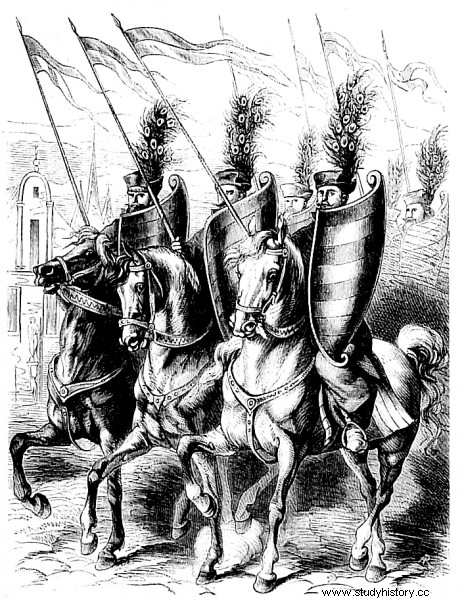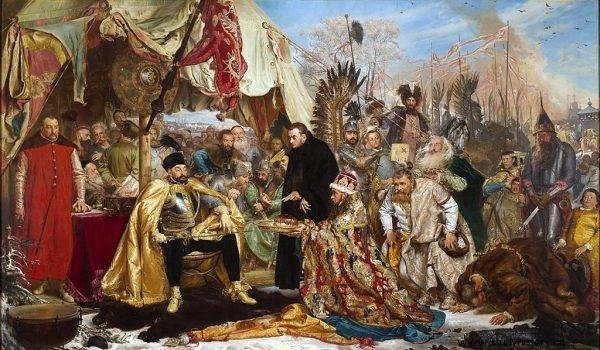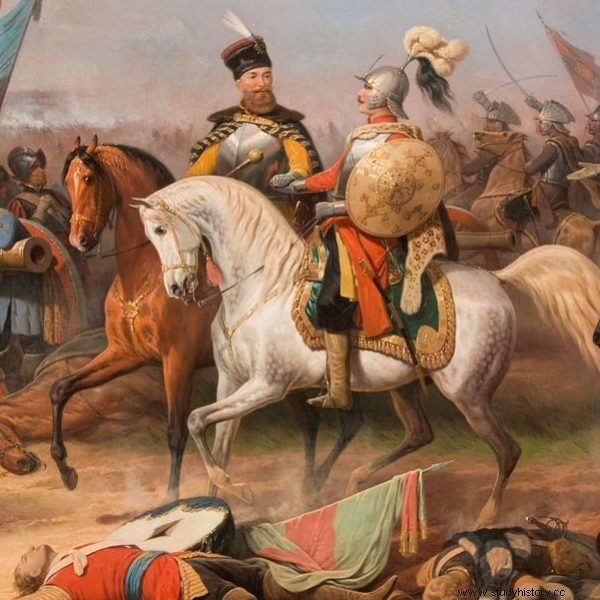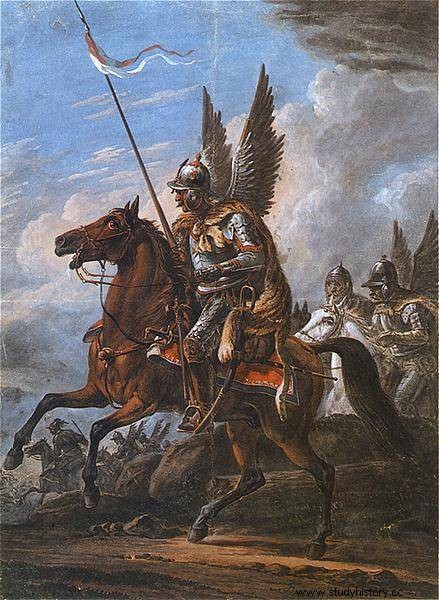The history of the cavalry, which turned the Commonwealth into an empire, begins with the Serbian mercenaries.
The very word "hussar" probably comes from the Serbian "usar / gusar", which was meant to mean a horse warrior. Other etymologies are proposed, even Armenian ones, but anyway the roots of the winged knights must be sought in the Balkans. Why suddenly there was a demand in Poland for warriors from the homeland of Nikola Tesla and Ana Ivanović?
It was the end of the 15th century. The wind of war was blowing from the east and south-east. The Crimean Tatars were becoming more and more aggressive, Moscow began to occupy Ruthenian lands at the expense of the Grand Duchy of Lithuania, and the Ottoman troops broke into Poland for the first time. The three of them operated with light cavalry, so it made little sense to send heavy spearmen against them.

The history of the cavalry, which turned the Commonwealth into an empire, begins with the Serbian mercenaries.
While the Tatars and Moscow had been fought for a long time, the Ottoman Turks were a new enemy who could really threaten the Polish capital. Suffice it to say that Krakow's Barbican was built to defend against the Ottomans . Some experience in battles with this enemy has been gained before, but it is quite another to incidentally fight in Moldova, and another to face seriously the empire at which Christian Europe trembled. Specialists had to be hired here.
Racowie
If a series were made about them, it might start out like A-teams :"If you have a problem, no one can help you and you are able to find them, you can turn to ... Raców." Racowie in a broader sense are Serbs, because in Latin texts, Serbia was often referred to as Regnum Racie . In a narrower sense, they mean Serbian cavalry, equipped with a long polearm, and their primary defensive weapon was a "Turkish shield" made of wood, with one elongated horn ..
The Serbs had a long tradition of fighting the Ottomans. Admittedly Muslims conquered more countries and in 1459 they wiped them out of the political map of Europe , but in other countries the warriors from the Balkans were appreciated. First they went to Hungarian service, and at the turn of the 15th and 16th centuries they found themselves on Polish and Lithuanian pay. Raców was also called hussars. Military historians try to draw the line between these concepts. As Aleksiandr Kazakou writes:
it is considered that hussars, unlike flares, used protective armament - chain mail. Soldiers appearing as flares were Serbs of origin, while the term hussar was associated with Hungarians .

Raców was also called hussars. Military historians are trying to draw a line between these concepts.
The difference between the two formations, however, was fluid, even the quoted Kazakou a paragraph later writes "racowie, or hussars." In each, Serbian mercenaries showed what they could do in cavalry charges in the battles with the Tatars at Kleck in 1506 and with Moscow at Orsza in 1514. They boasted about their military advantages in a specific way:they beheaded and taken the heads of defeated opponents.
Maybe the hussars would have remained a light ride, had it not been for Poland's success in the last war with the Teutonic Knights . Since, in 1525, Albrecht Hohenzollern, the first prince of Prussia, paid homage to King Sigismund I the Old, heavy-armed miners lost their importance. On the one hand, heavy riding was marginalized, on the other hand, the Hussar banners slowly evolved into ... heavy riding.
"For the sake of splendor and fear"
It started with chain mail. In 1531, in the battle with Moldovans at Obertyn, the first hussars fighting in cuirasses appeared, which protected the torso, but gave a lot of freedom of movement. King Stefan Batory, crowned in 1576, played a great role in the development of the hussars. The beginnings of his rule were extremely difficult:some of the nobility chose another king, the army was in a deplorable condition, and Gdańsk did not want to submit to him.
Getting ready to deal with the rebellious city, he enlisted Hussar banners. It determined their structure and armament. The ruler wished "that the horses of the soldiers should be good and strong", and they themselves had a helmet, iron gloves, a saber, as well as "feathers and other decorations for the splendor and fear of the enemy, according to the pleasure of each one. " Riding hard, but not quite. Military historian Zbigniew Hundert explains that:
the status of the hussars as heavy cavalry was due to the simultaneous disappearance of the full armor plate spearmen, which were replaced by hussars using half-chryslers. In fact, the Hussars were still a medium-armed cavalry, but in the face of the liquidation of heavy-armed coppers, they became a heavy cavalry in Polish conditions.

Stefan Batory hit the jackpot with the recruiting of the hussars.
Stefan Batory hit the jackpot with the enlisted hussars. In 1577, in the Battle of Lubieszów, their charge swept away the mercenaries hired by Gdańsk. The disproportion in losses was cosmic:the royal army had about 60 dead and 127 wounded, rebels - about four and a half thousand killed.
From the times of Batory, the composition of the banners began to be standardized. Previously, the term "hussar banner" usually meant that the majority are hussars, but soldiers of a different type also served there. Such a bit of a motley. The reorganization took a long time and was definitively completed in 1598 when the king was no longer born.
One hundred years of hussars triumphs
After the modifications, the hussars turned into a ride that could run over virtually any opponent. The time has come of the greatest victories of hussars in the history of Poland. The cavalry poured out enemies from all over the world. In 1588, near Byczyna, it won the triumph over the army of Archduke Maximilian, who dreamed of ruling over the Polish-Lithuanian Commonwealth. In 1600, she helped to sweep away the troops of Michał the Brave, the ruler of Moldavia and Wallachia, near Bukowa.
If a film were made in the war with the Swedes over Livonia at the beginning of the 17th century, it would have been titled “The Lithuanian Hussar Ride Massacre”. The enemy is outnumbered? No problem for me, give me a copy. This was the case in 1601 at Kokenhausen (the Republic of Poland had 3,500 people, Sweden - 4,900), three years later at Biały Kamień (2,300 to 5,000-7,000 soldiers) or in 1605 at Kircholm (3,700-4,350 Polish armed forces defeated 11,000-14,000 Swedes) . All these battles were won against arithmetic.
The numbers are approximate, but in this case a hundred more or less does not matter - it is about capturing the disparities. Kircholm in particular is impressive when compared to the losses. Jan Karol Chodkiewicz then achieved one of the greatest victories in the history of the military, allegedly losing 100 people compared to 9,000 on the Swedish side.

The Kircholm is impressive when you compare the losses. Jan Karol Chodkiewicz then achieved one of the greatest victories in the history of the military
Let's look at it from the other side. It is 1605, King Charles IX of Sweden leads an army of over 11,000 men and is swept away by an enemy with (at best) three times smaller forces!
Five years later, on July 4, 1610, with an even greater disproportion, Stanisław Żółkiewski near Kluszyn smashed the Moscow army, numbering over 30,000 people. Formerly it was believed that he had 7,000 soldiers under the command (including 5,556 hussars). Currently, it is assumed that he had only 2,500 cavalry and 200 walkers.
The Turks also found out about the strength of the hussars. In 1621, 600 cavalrymen of the Polish army left the camp near Khotyn and chased about 10,000 Ottomans from the field. Seeing this, Sultan Osman II reportedly burst into tears.
And this is how the successive victories of the Commonwealth can be listed, and end with a beautiful picture, when in 1683 near Vienna an army of allied Christian forces stopped to admire the winged knights rushing at the Turks in one of the greatest cavalry charges in history. Polish hussars became the savior of Europe.
Kopijnicy
If you indicate a weapon that defines a hussar, it is a long copy, made of pine or fir wood, with a steel tip at the end. As the already quoted Zbigniew Hundert writes:
The Hussar's copy was a specific weapon, very different from its knightly predecessor. Due to the fact that it was drilled inside from the height of the tip to the place where it was held by the hussar (i.e. to the knob), it could be used more effectively.
The hollow caused the spar's center of gravity to move closer to what was not hollowed out (the so-called tail). In this way the hussar could maximize the length of his weapons, and this was extremely important when charging into the ranks of the infantry a pikemen-musketeer with long polearms.
Such copies were 3.3 to 6.2 meters in length. Thanks to this, it was longer than the pikes of infantry and riders could reach defending infantry. In addition, the hussars had konceres, broadswords, sabers, pistols and even bows at their disposal.
What went wrong?
However, the hussars' charge was not always enough to win. Examples are the battles with the Swedes at Mitawa in 1622 and at Gniew in 1626. The latter, even hailed as "the first defeat of the hussars" . This historiographic myth was recently dealt with by Radosław Sikora, the best expert on the history of winged knights. The attack of the hussars was decisive for the outcome of the battle, but the cavalry had to be cleared of obstacles. This was the task of the infantry - when such support was lacking, it was impossible to win.

photo:Aleksander Orłowski / public domain However, the hussars' charge was not always enough to win.
A good illustration is the battle of Kliszów, where in 1702 the Polish hussars failed to cope with the Swedish infantry. Formerly it was believed that the key to the success of the Scandinavians was the use of modern flintlock muskets. As Radosław Sikora showed, the muskets were not a problem for Polish driving. They withstood the first volley, but the problem was that they got stuck on the "shakers" (probably beams with drilled holes in which sharpened piles or pikes were stuck), and the Swedes managed to fire another one.
The eighteenth century is the decline in the importance of this formation in the history of Poland. The Polish Republic fell into decline, the society became impoverished, there were no leaders of the likes of Chodkiewicz, Żółkiewski or Jan Sobieski, and the nobility was not so eager to join the Hussar banners. Even academic researchers are not really keen to accurately describe the slow dying of the winged knights of the Polish army. The symbolic end of the hussars is considered to be the year 1775, when the national cavalry was established, although in the sources from 1780 you can come across cavalry brigades called hussars. Today, many military units, especially those derived from armored forces, refer to the symbolism and tradition of the Hussars.
